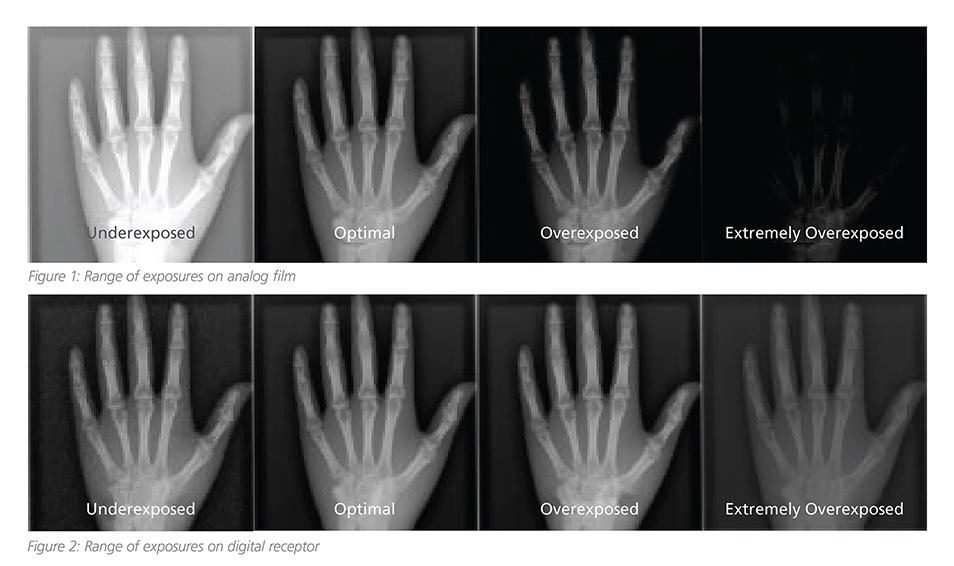

Radiation exposure is not applicable to describe neutrons, charged particles or all interactions taking place within a body. It must be emphasized that this concept applies only to X-rays or γ-rays in air at a point outside a body. Since the amount of radiation exposure depends directly (linearly) on the time people spend near the source of radiation, the exposure is equal to the strength of the radiation field (exposure rate) multiplied by the length of time spent in that field. In conventional units, it is measured in mR/sec or R/hr. The exposure rate is therefore defined as: It is a measure of exposure intensity (or strength). The radiation exposure rate is the rate at which an exposure is received. A table giving the exposure to dose conversion for various materials for a variety of gamma ray energies can be found in literature.

Therefore, an exposure of 2.58×10 −4 C/kg (1 roentgen) would deposit an absorbed dose of 8.76×10 −3 J/kg (0.876 rad) in dry air at those conditions. This can be determined using the ionization energy of dry air at 20 ☌ and 101.325 kPa of pressure, which is 33.97 J/C. Although a large number of possible interactions are known, there are three key interaction mechanisms of gamma rays with matter.įor instance, for an exposure of 1 roentgen by gamma rays with an energy of 1 MeV, the dose in air will be 0.876 rad. For a given radiation field, the absorbed dose will depend on the type of matter which absorbs the radiation. Conversion: Exposure to Absorbed Doseĭose is defined as the amount of energy deposited by ionizing radiation in a substance. For example, if soft tissue is exposed to γ-rays of 1 R, the radiation dose will be approximately 9.3 milligray (mGy).

To calculate the radiation dose (in Gy) from a radiation exposure of 1 R depends on the energy of the X-rays or γ-rays and the composition of the irradiated material. Radiation exposures measured in industry (except nuclear medicine) often have comparable doses to one roentgen and the following multiples are often used: As a result, one roentgen corresponds to 2.58 x 10 -4 coulomb per kg of ions generated in air and an exposure of one coulomb per kilogram is equivalent to 3876 roentgens. In the original definition 1 R means the amount of X-rays or γ-radiation that is required to liberate positive and negative charges of one electrostatic unit of charge (esu) in 1 cm³ of dry air at standard temperature and pressure (STP). The roentgen, abbreviated R, is the unit of radiation exposure. The SI unit of radiation exposure is the coulomb per kilogram (C/kg), but in practice, the roentgen is used. Radiation exposure is given the symbol X. Radiation exposure is defined as the sum of electrical charges (∆q) on all the ions of one sign produced in air when all the electrons, liberated by photons in a volume of air whose mass is ∆m, are completely stopped in air. Personal diagnostic radiation exposure records as recommended by the National Academy of Sciences may possibly be kept by expanding the system of occupational exposure records now maintained in most industrial medical departments.Radiation exposure is a measure of the ionization of air due to ionizing radiation from high-energy photons (i.e. Three simple steps are emphasized: use a cone or diaphragm of minimum practicable size to reduce the dose to all areas outside the field of interest, use filtration at the source to reduce the amount of soft, scattered radiation, and use the highest kilovoltage and lowest milliamperage technique which is practicable. Minimizing the number of abdominal examinations is most important, particularly in children, but minimizing the gonad dose during each examination should not be overlooked. Although only 5% of the total male examinations were of the abdominal area, they contributed 81 % of the total male gonad dose. The average total gonadal dose per year was 0.013 rads for males and 0.035 rads for females. The frequency of the various types of examination was also studied.
EXPOSURE X RAY SKIN
A manikin was constructed to permit measurement of the radiation received by skin and gonads during examinations of the chest, knee, abdomen, pelvis, and vertebral column. The doses of x-ray received by employees of the Oak Ridge National Laboratory were investigated for the purpose of estimating the total exposure to ionizing radiation received both within and outside the medical facilities of the ORNL.


 0 kommentar(er)
0 kommentar(er)
